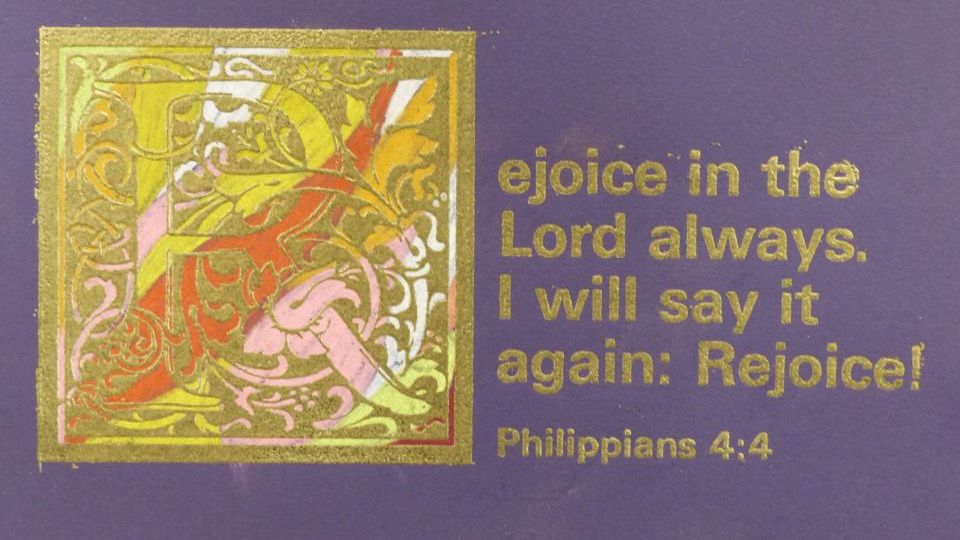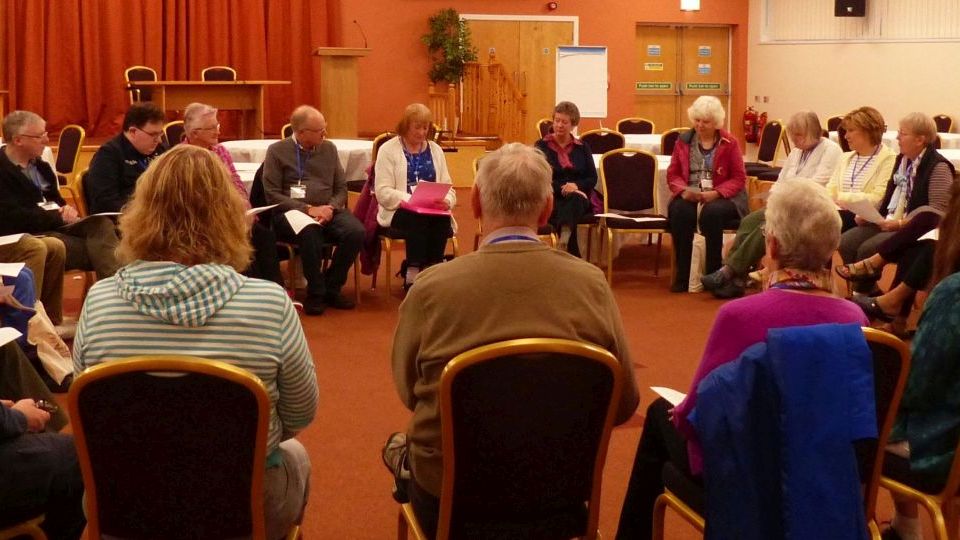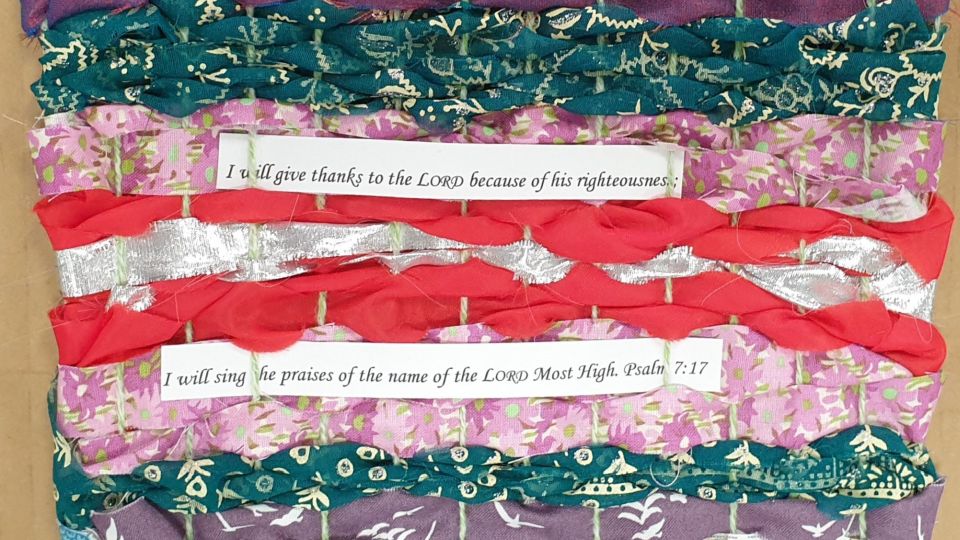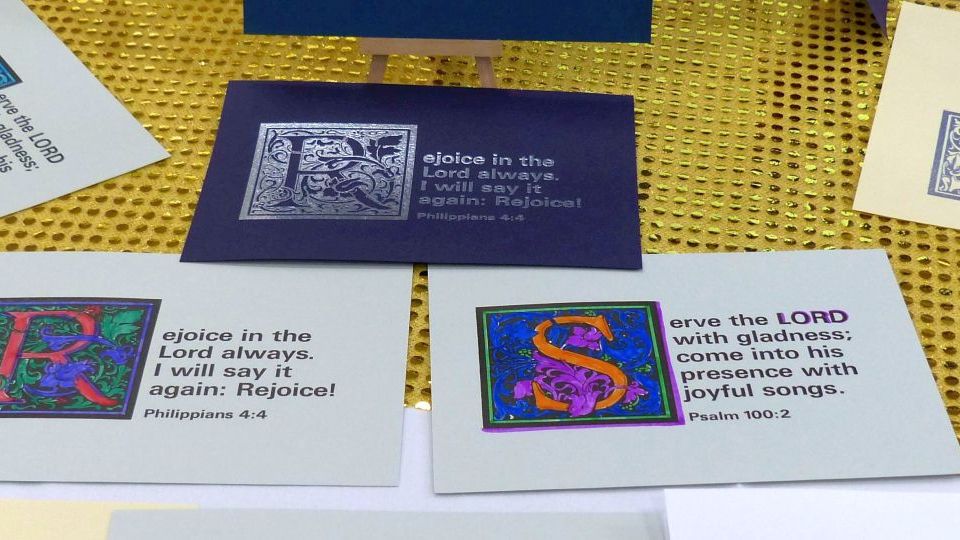Singing the Faith is the latest Methodist Church hymn book, published in September 2011. Its website Singing the Faith Plus complements and supplements the book.
Singing the Faith can be seen as more than just a hymn book. It can be an opportunity to broaden our worship experience through drama, art and story. ArtServe member and composer Valerie Ruddle offers suggestions based on seasons of the church calendar.
Singing the Faith offers new hymns for each season, but you may also like to consider presenting familiar ones in different ways. Hymns old and new often lend themselves to more than just a straight sing through. Be imaginative! Don’t always sing the whole text. Remember too that pencil and paper activities for the young can be linked with what is sung.
Advent
Singing the Faith offers several new hymns for Advent and you may like to consider presenting familiar ones in a different way. Valerie Ruddle offers some suggestions.
Advent candles
Diminishing candles indicate the passing of time better than ones that burn more slowly, so use slender candles on the Advent wreath and light the same one first each week.
Advent candles tell their story (Mark Earey) - 165
One verse per week. Sing it, talk about it, sing it again. Allow time for what it says to be taken in.
Christmas is coming (John Bell) - 166
Best as an accumulating song, adding a verse every week. Alternately, read the verses, sing the choruses.
Light a candle in a darkened place (Claire Stainsby) - 174
Another progressive song. Use as solo or choir item the first week, after which everyone will be ready to join in. Prepare young children to sing ‘So let it burn’ at each verse end.
Other songs
Focus on a verse or two rather than always singing the whole hymn. Doing more with less can create a greater impact.
Sing we the King (Charles Silvester Horne) - 185
Just verse one and chorus to remind ourselves that, even in Advent, Jesus is not an unborn baby now! He is with us!
Longing for light (Bernadette Farrell) - 706
Use verses 1 and 2 and the chorus.
There’s a light upon the mountains (Henry Burton) - 188
Take a verse a week and highlight a single word from it.
For example, v.1 - waiting, v.2 - expectation, v.3 - barriers, v.4 - meet.
Praise to the God who cheers the way (Jan Berry) - 183
A new hymn to a delightful tune that is probably already known (see StF 509)
Prayer responses
A sung response allows more time for reflection than a hastily said ‘Hear our prayer’.
Come, Lord Jesus, come (Francesca Leftley) - 168
Take it slowly as a prayer response, with brief spoken prayers between the verses. The descant can be played by flute or recorder to some verses. Alternately, vocalise with ‘ah’ or sing ‘Come, Lord Jesus’ to every bar.
O come, O come, Immanuel - 180
Sing the refrain only, as a response in unison or harmony.
Alleluia - 755 and 756
One of these settings could be used as a response to prayers of adoration or thanksgiving.
Read
Words read can sometimes make a greater impact than when sung.
Wild and lone the prophet’s voice (Carl Daw) - 189
Invite various sections of the congregation to read the first half of each verse, with everyone joining in each second half, followed by space for reflection as the tune is played quietly.
Magnificat - 793
Use women/men for dark/light print. All say the Gloria
Visuals
Prepare cut-outs for colouring and sticking, to build a series of pictures or one large composite picture to illustrate the aspects of Advent or other topical hymn.
Colours of day (Sue McClellan & others) - 167
Throughout Advent, gradually build a ‘Spread the Word’ frieze to stretch around the church by Christmas Day, showing local outreach activities.
Movement
People of all ages like a bit of body movement occasionally.
Long ago prophets knew (Fred Pratt Green) - 178
Add some movement to the refrain as a circle dance or in the pews:
Ring, bells, ring, ring, ring - step, close, step, close, etc; repeat in opposite direction
When he comes, when he comes - look upwards, raise arms and lower them slowly
Who will make him welcome - then turn on the spot.
Make way, make way (Graham Kendrick) - 264
Verses: face a partner and offer right and left hand alternately as you move around the circle (grand chain)
Chorus: face partner and clap (two bars), then turn your partner (two bars). Repeat.
Epiphany
Some well-known and newer items suitable for use during the Epiphany season lend themselves to more than just a straight sing through. Be imaginative! Don’t always sing the whole text. Remember too that pencil and paper activities for the young can be linked with what is being sung.
Darkness like a shroud (Graham Kendrick) - 170
Read the verses, sing the refrain.
Like a candle flame (Graham Kendrick) - 176
Use just the refrain as a prayer response.
Love came down at Christmas (Christina Rosetti) - 210
Prepare the letters LOVE (or the words GOD IS LOVE) for colouring with space for a picture border.
A special star (Lynda Masson) - 223
Prepare a five-pointed Epiphany star to be cut out. A letter of the word JESUS can then be put at each point.
Birth brings a promise of new life awaking (Marjorie Dobson) - 226
Read each verse separately, leaving space for comment or reflection between each.
Hail to the Lord’s Anointed (James Montgomery) - 228
Based on Psalm 72, the appointed psalm for Epiphany.
Mary and Joseph came to the Temple (Andrew Pratt) - 229
If you don’t fancy trying the new tune BENSUNAS, use BUNESSAN!
Riding out across the desert (Peter Ratcliffe) - 230
THE CAMEL SHUFFLE is a delightful tune which is sure to catch on quickly. It might be best if each four bar phrase is sung first by the leader and then by all. A procession of wise men with retinues around the church to the crib would be appropriate. The significance of the gifts could be explained.
The silent stars shine down on us (Herman G Stuempfle) - 231
These new words sing well to KINGSFOLD. A galaxy of stars might be created.
Joy to the world (Isaac Watts) - 330
Try a circle dance. Make two circles facing a partner:
Joy to the world, the Lord is come - hold hands with partner and walk clockwise (step-close-step-close etc)
Let earth receive her King - pass partners right shoulder and back to left (doh-si-doh)
Let every heart prepare him room - hold hands with partner and walk clockwise
And heaven and nature sing, and heaven and nature sing - outer circle dance round clockwise and inner circle go in the opposite direction
and heaven, and heaven and nature sing - turn on the spot, then face new partner ready for the next verse.
Passiontide
Singing The Faith has a wealth of wonderful hymns for Passiontide and Easter. As well as singing them, I want to encourage you to read them, to respond to them through body movement and to take time to reflect on what Christ’s death and resurrection really means. Here are a few suggestions.
Hosanna, hosanna (Carl Tuttle) - 263
Percussion instruments can add effectively to a palm waving procession. Aim for a varied rhythm, playing at the rests rather than a steady beat throughout.
Make way, make way (Graham Kendrick) - 264
Set the scene with suitable words before the congregation leave their seats ‘to travel towards Jerusalem’. Stand still to sing the verses, move on during each refrain.
Come, wounded Healer (Martin Leckebusch) - 271
Choose from the lilting unison tune or the one with SATB, depending not only on singers available but also on where and when it is to be sung. Whichever you use, take it slowly and quietly, perhaps seated, in a reflective mood. Don’t always sing loudly!
Jesus, the carpenter, hanging on Calvary (Marjorie Dobson) - 275
Read the verses, perhaps as the tune is played softly in the background by a solo Instrument, then sing the refrain. The refrain only may be enough new music for the congregation.
My song is love unknown (Samuel Crossman) - 277
A beautifully told story to a lovely tune but seven verses can become wearisome. Sing the first two and last two and ask six people to read four lines each of verses 3, 4 and 5 as dramatically as they can.
What kind of love is this? (Bryn & Sally Haworth) - 286
This song could effectively be sung as a solo or read as the tune is played. It would also suit a simple liturgical dance. Three or four dancers might move freely one by one towards a central cross and form a tableau at the end.
When I think about the cross (Mark & Helen Johnson) - 288
What do you think when you meditate on the cross? People may like a chance to offer their own thoughts by writing short pieces of verse or prose to be read, each of which could be followed by the singing of this beautiful single verse.
When you prayed beneath the trees (Christopher Idle) - 339
I am not sure that KELVINGROVE really suits these words. Try Ian Howarth’s EFFINGHAM (450ii). To make It was for me, O Lord really personal, use two solo voices (two lines each) for the first half of each verse.
Easter
Singing The Faith has a wealth of wonderful hymns for Passiontide and Easter. As well as singing them, I want to encourage you to read them, to respond to them through body movement and to take time to reflect on what Christ’s death and resurrection really mean. Here are a few suggestions.
Alleluia, alleluia (Don Fishel) - 295
Sing the verses encouraging appropriate arm movements and facial expressions. During the refrains, interact with a partner.
Alle - face a partner to begin
- lu - ia, alle - clap own hands, then partner’s right, then left
- lu - ia, give - repeat above
thanks to the - sweep right arm up and out
risen Lord, alle - sweep left arm up and out
- lu - ia, alle - clap own hands, then partner’s right, then left
- lu - ia, sing - repeat above
praise to his name. - raise both arms up and look upwards.
Easter jubilation fills the streets and towns (Mark & Helen Johnson) - 299
Note the words ‘Let your feelings out’! Get excited about the Easter message! Show some emotion! You may feel like dancing round the church! Why not? Join hands in a circle and move clockwise. You might try the Israeli step:
Step with the right foot in front of the left foot,
then step with the left foot to the left.
Step with the right foot behind the left foot,
then step with the left foot to the left.
It is easier if you bend the knees slightly.
Jesus is risen (Bernard Kyamanywa) - 304
To accompany this lively song from Tanzania, make a series of pictures with a caption from each verse: Lost to the tomb, Buried for three days, Don’t be afraid, Go and tell others, Christ has arisen, and Let the earth sing.
On the day of resurrection (Michael Peterson) - 307
Write the final line of each verse boldly on separate sheets to display as the song is sung. Then take time to reflect on the journey we take with Jesus.
On the journey to Emmaus (Marty Haugen) - 308
Use this hymn instead of the Emmaus reading. Split the verses between two readers or soloists, two lines each.
See what a morning, gloriously bright (Stuart Townend & Keith Getty) - 309
If the first half of each verse is sung by ladies (two lines) and then men (two lines), the second half sung all together will have a greater impact.
Sing a song, sing a joyful song (Mark & Helen Johnson) - 310
Sing the refrain for a couple of weeks before introducing the verses with action. Each first line could be sung by a soloist to introduce the next action.
When Easter to the dark world came (WH Hamilton) - 316
The verses lend themselves to some drama. Talk through the story as the characters are chosen and rehearsed. For the refrain, everyone joins hands in small circles:
Step forward and back twice, swinging arms (4 bars)
then turn slowly on the spot.
The characters should not take part in the refrain prior to their verse as they prepare for their action.
Pentecost
More than half the items in the Holy Spirit section of Singing the Faith (numbers 369 - 400) were not in Hymns and Psalms so there is a lot of new material to explore. Remember too, that as the Holy Spirit is ever-present, hymns in this section are appropriate for any time of the year. Words can sometimes have a greater impact if they are listened to while others sing them. Several of the following hymns can be split effectively between ‘listening’ and ‘singing’ groups.
Breathe on me, Spirit of Jesus (Tina Pownall) - 371
Simple words and a gentle tune with a change of key for verse 4. It also works well to use the music for verse 4 for verse 2, ending with an additional chord (G7) to lead back to key C for verse 3.
Come, Holy Spirit (John Bell) - 374
Use for prayers of intercession, with a few spoken words between each verse as the tune is played or hummed.
Holy Spirit, breath of heaven (Geraldine Latty) - 381
Read the words, emphasizing the final line of each verse.
Holy Spirit, gift bestower (from Church Hymnary, 4th edition) - 383
This lovely Welsh melody stands well on its own, without harmony. There is not much to learn as three of the four phrases are identical!
Holy Spirit, rain down (Russell Fragar) - 384
A brisk pace and the thumping beat of the accompaniment, especially if drums are added, gives a powerful sense of urgency.
Into a world of dark (Ann Phillips) - 387
Paul Wood’s double tune brings new life to these words.
Let every Christian pray (Fred Pratt Green) - 388
Of all Paul Leddington Wright’s tunes in this book, I think CHERRYWOOD is the best.
Like the murmur of the dove’s song (Carl Daw) - 389
A known tune with new words, best sung if half the congregation sings the first two lines, and the other half the next two lines, with everyone joining in the final line.
Spirit of God, unseen as the wind (Margaret Old) - 394
Invite two different groups to sing a verse each, with the refrain by all.
The Spirit lives to set us free (Damian Lundy) - 397
Why stand still when singing ‘walk’? Give this old favourite a bit of movement! Join hands in a circle and walk round during the refrains, turning on the spot for the final phrase ‘Walk in the light of the Lord’. Alternatively, if you are restricted by pews, step to and fro sideways as space allows, then turn on the spot.
There’s a Spirit in the air (Brian Wren) - 398
Ask the women to start the odd verses and the men the even, with everyone singing the alternating refrain.
Wind of God, dynamic Spirit (Michael Saward) - 400
Strong new words by the author of Christ triumphant and a strong tune by Arthur Sullivan – a tune sung in years gone by to Glorious things of thee are spoken (and also set in this book to Timothy Dudley-Smith's We believe in God the Father).
Come, O Lord - 759
Use the Lourdes Gospel Acclamation before the readings.
May the love of the Lord - 771
A gentle benediction for Pentecost - or any Sunday.
Harvest
Some suggestions for incorporating Singing the Faith into your harvest celebrations.
Come all you people (Iona Community) - 22
Start with solo voice singing this unaccompanied song once and add two or three more voices as it is sung a second time. Then they move around the congregation as they continue to sing, encouraging everyone to join in.
Come, you thankful people, come (Henry Alford) - 123
Of course there must be some of the old favourites people are expecting!
Amen, siakudumisa (We praise your name) - (South Africa) - 770
This can be sung by everyone unaccompanied as they bring their gifts forward.
Alleluia - 755, 756, 758
There are several setting of Alleluia which could be used as a prayer response.
Autumn days (Estelle White) - 121
This may be known to children through BBC programmes. Art work to match the verses could have been prepared the week before by all ages, including adults, during coffee time.
We plough the fields (Matthias Claudius tr. JM Campbell) - 130
Gather pictures from magazines for the under-8's to make a collage based on this hymn towards the end of the service when they are getting bored.
Praise God for the harvest (Brian Wren) - 126
These words from HP 351 are now set to a more appealing tune, but five verses with long lines can still be daunting. If the ladies and children are asked to sing every first line, men the second and all lines 3 and 4. it will be less monotonous.
Touch the earth lightly (Shirley Erena Murray) - 729
Based on Genesis 9: 7-17, this thoughtful text, set to Colin Gibson's gently tune, can be very moving. A few voices singing the second verse in the minor key as suggested can be very effective.
Always remember, never forget (Lynda Masson) - 70
Thanksgiving is probably the central theme of most harvest services and this jaunty tune calls for movement! The simple circle dance below for the refrain could be adapted to movement in pews. The verses should be sung standing still. Some new verses might be created.
Always remember, never forget - eight steps clockwise
Never forget to say - turn on the spot
Thank you - clap twice
Always remember, never forget - eight steps anti-clockwise
Always say, ‘Thank you, Lord' - turn on the spot and clap after Lord.
Sing of the Lord's goodness (Ernest Sands) - 65
A great hymn of praise to end! Don't be put off by 5/4 time!
Also by Valerie Ruddle: Read the hymn book - a seasonal exploration of Singing the Faith.


.jpg)






